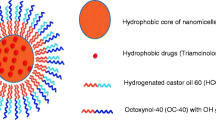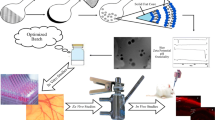Abstract
Tenoxicam (TX) is a non-steroidal anti-inflammatory agent that can be used to control pain in various ophthalmic lesions like cataracts, refractive surgery, and corneal abrasion. TX has a very slightly aqueous solubility of 0.072 mg/mL resulting in difficulty to be formulated in ophthalmic solutions. This study aims to improve TX solubility by converting it into its potassium salt to achieve a target of 10 mg/mL (1%w/v) concentration of TX in the desired aqueous medium for the formulation of aqueous ophthalmic solutions. The synthesized TX salt was characterized by different evaluation parameters such as solubility studies, 1H NMR, IR, and elemental analyses. Different TX potassium solutions were formulated at concentrations of 0.5% and 1% w/v using different viscosity-imparting agents. The prepared solutions were characterized for their physicochemical properties including visual inspection, pH, rheological, in vitro release, and kinetic behavior. Also, the formulations were biologically evaluated in vivo using male albino rabbits. The obtained results showed the successful synthesis of TX salt, as indicated by IR and NMR, and elemental analysis. The solubility study showed that the solubility of TX was improved hugely to 18 mg/mL (250-fold). In addition, the results showed that the prepared formulations showed acceptable physicochemical properties. The highest release rate was obtained with formula F1, which contains no viscosity-imparting agents. While as, the lowest release rate was obtained in the case of formula F9, composed of Pluronic F127 (12% w/v). The in vivo results showed that TX optimized ophthalmic solutions F8 and F9 inhibited the redness and edema in an extended or sustained manner.








Similar content being viewed by others
References
Palani S, Joseph NM, Goda C, Zachariah A, Ayenew Z. Ocular drug delivery: a review. Int J Pharm Sci Res. 2010;1:1–11.
Zafar A, Alsaidan OA, Imam SS, Yasir M, Alharbi KS, Khalid M. Formulation and evaluation of moxifloxacin loaded bilosomes in-Situ gel: optimization to antibacterial evaluation. Gels. 2022;8:418. https://doi.org/10.3390/gels8070418.
Gilani SJ, Jumah MNB, Zafar A, Imam SS, Yasir M, Khalid M, Alshehri S, Ghuneim MM, Albohairy FM. Formulation and evaluation of nano lipid carrier-based ocular gel system: optimization to antibacterial activity. Gels. 2022;8:255. https://doi.org/10.3390/gels8050255.
Lang LC. Ocular drug delivery conventional ocular formulations. Adv Drug Deliv Rev. 1995;16:39–43.
Jani R, Lang JC, Rodeheaver DP, Missel PJ, Roehrs RE, Chowhan MA. Design and evaluation of ophthalmic pharmaceutical products. Modern pharmaceutics: fifth ed. CRC Press, eBook ISBN 9780429148293; 2010.
Ding S. Recent developments in ophthalmic drug delivery. Pharm Sci Technol Today. 1988;1:328–35.
Patel P, Shastri D, Shelat P, Shukla A. Ophthalmic drug delivery system: challenges and approaches. Syste Rev Pharmacy. 2010;1:113–20.
Yeh M-K, Chang L-C, Chiou AH. Improving tenoxicam solubility and bioavailability by cosolvent system. AAPS PharmSciTech. 2009;10(1). https://doi.org/10.1208/s12249-009-9189-2.
Al-Obaid AM, Mian MS. Analytical profiles of drug substances and excipients 1993;22:431–59.
Cho H, Wolf KJ, Wolf EJ. Management of ocular inflammation and pain following cataract surgery: focus on bromfenac ophthalmic solution. Clin Ophthal. 2009;3:199–210.
Da Silva FLO, Marques MBD, Kato KC, Carneiro G. Nanonization techniques to overcome poor water-solubility with drugs. Expert Opin Drug Discov. 2020;15:853–64.
Kumar KS, Bhowmik D, Paswan S, Srivastava S. Recent challenges and advances in ophthalmic drug delivery system. Pharma Innov. 2012;4:1–15.
Charoenchaitrakool M, Dehghani F, Foster N, Chan H. Micronization by rapid expansion of supercritical solutions to enhance the dissolution rates of poorly water-soluble pharmaceuticals. Ind Engin Chem Res. 2000;39:4794–802.
Komala DR, Janga KY, Jukanti R, Bandari S, Vijayagopal M. Competence of raloxifene hydrochloride loaded liquisolid compacts for improved dissolution and intestinal permeation. J Drug Deliv Sci Technol. 2015;30:232–41.
Wempe MF, Wacher VL, Ruble KM, Ramsey MJ, Edgar KJ, Buchanan NL, et al. Pharmacokinetics of raloxifene in male Wistar-Hannover rats: influence of complexation with hydroxybutenyl-beta-cyclodextrin. Int J Pharm. 2008;346:25–37.
Elsheikh MA, Elnaggar YS, Gohar YS, Abdallah OY. Nanoemulsion liquid preconcentrates for raloxifene hydrochloride: optimization and in vivo appraisal. Int J Nanomed. 2012;7:3787–882.
Zafar A, Ali J, Bhatnagar A, Kumar N, Ali A. Chitosan nanoparticles amplify the ocular hypotensive effect of cateolol in rabbits. Int J Biol Macromol. 2014;65:479–91.
Zafar A, Khanb N, Alruwailia NK, Bukharic SNA, Alsuwaytd B, Afzale M, Akhtere S, Yasirf M, Elmowafya M, Shalabya K, Alib A. Improvement of ocular efficacy of levofloxacin by bioadhesive chitosan coated PLGA nanoparticles: box-Behnken design, in-vitro characterization, antibacterial evaluation and scintigraphy study. Iran J Pharm Res. 2020;19(1):292–311. https://doi.org/10.22037/ijpr.2019.15318.13016.
Bin-Jumah M, Gilani SJ, Jahangir MA, Zafar A, Alshehri S, Yasir M, Kala C, Taleuzzaman M, Imam SS. Clarithromycin-loaded ocular chitosan nanoparticle: formulation, optimization, characterization, ocular irritation, and antimicrobial activity. Int J Nanomed. 2020;15:7861–75.
Gurunath S, Kumar SP, Basavaraj NK, Patil PA. Amorphous solid dispersion method for improving oral bioavailability of poorly water-soluble drugs. J Pharm Res. 2013;6:476–80.
Elgindy N, Elkhodairy K, Molokhia A, Elzoghby A. Lyophilization monophase solution technique for improvement of the physicochemical properties of an anticancer drug, flutamide. Eur J Pharm Biopharm. 2010;74:397–405.
Verbeeck R-K, Kanfer I, Walker RB. Generic substitution: the use of medicinal products containing different salts and implications for safety and efficacy. Eur J Pharm Sci. 2006;28:1–6.
Tantishaiyakul V. Prediction of aqueous solubility of organic salts of diclofenac using PLS and molecular modeling. Int J Pharm. 2004;275:133–9.
Kasten G, Lobo L, Dengale S, Grohganz H, Rades T, Löbmann K. In vitro and in vivo comparison between crystalline and co-amorphous salts of naproxen-arginine. Eur J Pharm Biopharm. 2018;132:192–9.
Sinha V, Kumar R, Singh G. Ketorolac tromethamine formulations: an overview. Exp Opin Drug Deliv. 2009;6:961–75.
Higuchi T, Connors A. Phase-solubility techniques. Adv Anal Chem Instrum. 1965;4:117–212.
Mândrescu M, Spac AF, Dorneanu V. Ultraviolet spectrophotometric determination of tenoxicam using iodine solution as reagent. Rev Med Chir Soc Med Nat Iasi. 2009;113(2):598–603.
Asasutjarit R, Theerachayanan T, Kewsuwan P, Veeranodha S, Fuongfuchat A, Ritthidej GC. Development and evaluation of diclofenac sodium loaded-N-trimethyl chitosan nanoparticles for ophthalmic use. AAPS PharmSciTech. 2015;16(5):1013–24. https://doi.org/10.1208/s12249-015-0290-4.
Singhvi G, Singh M. In-vitro drug release characterization models. Int J Pharm Stud Res. 2011;2(1):77–84.
Baeyens V, Felt-Baeyens O, Rougier S, Pheulpin S, Boisrame B, Gurny R. Clinical evaluation of bioadhesive ophthalmic drug inserts (BODI®) for the treatment of external ocular infections in dogs. J Control Rel. 2002;85:163–8.
Liu Z, Nie S, Guo H, Pan W, Li J. Effects of Transcutol P on the corneal permeability of drugs and evaluation of its ocular irritation of rabbit eyes. J Pharm Pharmacol. 2006;58(1):45–50.
Mishra V, Jain N. Acetazolamide encapsulated dendritic nano-architectures for effective glaucoma management in rabbits. Int J Pharm. 2014;461:380–90.
**e Y, Yuan P, Heng T, Du L, An Q, Zhang B, Zhang L, Yang D, Du G, Lu Y. Insight into the formation of cocrystal and salt of tenoxicam from the isomer and conformation. Pharmaceutics. 2022;14:1968. https://doi.org/10.3390/pharmaceutics14091968.
Bawazeer S, El-Telbany DFA, Al-Sawahli MM, Zayed G, Keed AAA, Abdelaziz AE, Abdel-Naby DH. Effect of nanostructured lipid carriers on transdermal delivery of tenoxicam in irradiated rats. Drug Deliv. 2020;27:1218–30.
Bolla G, Sanphui P, Nangia A. Solubility advantage of tenoxicam phenolic cocrystals compared to salts. Cryst Growth Design. 2013;13:1988–2003.
Abdallah DJ, Sirchio SA, Weiss RG. Hexatriacontane organogels. The first determination of the conformation and molecular packing of a low-molecular-mass organogelator in its gelled state. Langmuir. 2000;16:7558–61.
Shriky B, Kelly A, Isreb M, Babenko M, Mahmoudi N, Rogers S, Shebanova O, Snow T, Gough T. Pluronic F127 thermosensitive injectable smart hydrogels for controlled drug delivery system development. J Colloid Interface Sci. 2020;565:119–30.
Choi H-G, Lee M-K, Kim M-H, Kim C-K. Effect of additives on the physicochemical properties of liquid suppository bases. Int J Pharm. 1999;190:13–9.
Ryu J-M, Chung S-J, Lee M-H, Kim C-K, Shim C-K. Increased bioavailability of propranolol in rats by retaining thermally gelling liquid suppositories in the rectum. J Control Rel. 1999;59:163–72.
Wei G, Xu H, Ding PT, Li SM, Zheng JM. Thermosetting gels with modulated gelation temperature for ophthalmic use: the rheological and gamma scintigraphic studies. J Control Rel. 2002;83:65–74.
Swapnil D, Sonawane LS. Design and evaluation of ion induced in situ gel formulation for levofloxacin hemihydrateocular delivery. Int J Pharm Sci Invent. 2014;3:38–43.
Auda SH, El-Rasoul SA, Ahmed MM, Osman SK, El-Badry M. In-vitro release and in-vivo performance of tolmetin from different topical gel formulations. J Pharm Investig. 2015;45:311–7.
Roggeband R, York M, Pericoi M, Braun M. Eye irritation responses in rabbit and man after single applications of equal volumes of undiluted model liquid detergent products. Food Chem Toxicol. 2000;38:727–34.
ElKasabgy NA. Ocular supersaturated self-nanoemulsifying drug delivery systems (S-SNEDDS) to enhance econazole nitrate bioavailability. Int J Pharm. 2014;460:33–44.
Schmolka IR. Artificial skin I. Preparation and properties of pluronic F-127 gels for treatment of burns. J Biomed Mater Res. 1972;6:571–82.
Acknowledgements
The authors are thankful to the Researchers Supporting Project number (RSP2023R516) at King Saud University, Riyadh, Saudi Arabia. Also, the authors would like to thank the Deanship of Scientific Research at Shaqra University for supporting this work.
Author information
Authors and Affiliations
Contributions
Conceptualization, S.K. Osman, and M.A. Ibrahim; Data curation, T.M. Yassin, A.M. Mohamed, A.M. Alfayomy, and S.K. Osman; Formal analysis, A.M. Mohammed, T.M. Yaseen, A.M. Alfayomy, and S.K. Osman; Investigation, A.A.H. Abdellatif and S.K. Osman; Methodology, S.K. Osman, T.M. Yassin, and A.M. Mohamed; Project administration, M.A. El Hamd, A.A.H. Abdellatif, M.A. Ibrahim, and S.K. Osman; Resources, A.A.H. Abdellatif, H. Sarhan, and S.K. Osman; Software, A.M. Mohammed, W.A. Mahdi, S. Alshehri, and M.A. Ibrahim; Validation, M.A. El Hamd, A.A.H. Abdellatif and A.M. Alfayomy; Visualization, T.M. Yaseen, M.A. Ibrahim, and S.K. Osman; Writing—original draft, A.M. Mohammed, T.M. Yassin, and S.K. Osman; Writing—review and editing, H. Sarhan, A. H. Abdellatif, W.A. Mahdi, S. Alshehri, and S. K. Osman.
Corresponding authors
Ethics declarations
Conflict of Interest
The authors declare no competing interests.
Additional information
Publisher's Note
Springer Nature remains neutral with regard to jurisdictional claims in published maps and institutional affiliations.
Supplementary Information
Below is the link to the electronic supplementary material.
Rights and permissions
Springer Nature or its licensor (e.g. a society or other partner) holds exclusive rights to this article under a publishing agreement with the author(s) or other rightsholder(s); author self-archiving of the accepted manuscript version of this article is solely governed by the terms of such publishing agreement and applicable law.
About this article
Cite this article
Osman, S.K., Yassin, T.M., Mohammed, A.M. et al. A Novel Approach for the Availability and Ocular Delivery of Tenoxicam Potassium: Synthesis, Characterization, and In Vivo Application. AAPS PharmSciTech 24, 44 (2023). https://doi.org/10.1208/s12249-022-02487-3
Received:
Accepted:
Published:
DOI: https://doi.org/10.1208/s12249-022-02487-3




